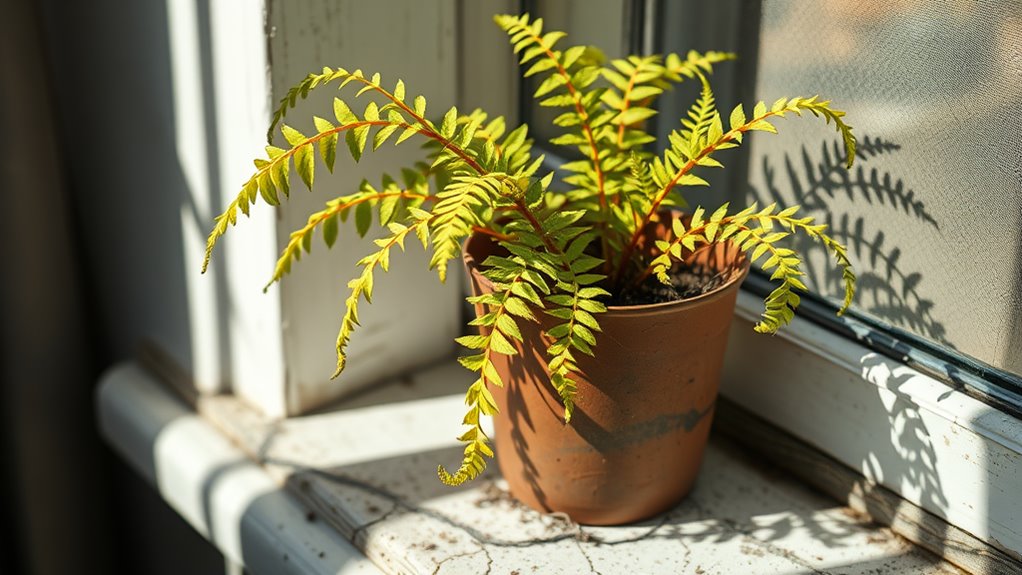This Is Why Your Plants Keep Dying Indoors!
You’re overwatering your plants, drowning roots and causing rot, or underwatering them, leading to wilting and dehydration. Insufficient light stretches stems thin, while too much burns leaves and bleaches colors. Improper temperature or low humidity curls foliage and stresses growth, and wrong pots or soil restrict roots. Neglected pests and diseases spread quickly, inviting infestations. Tackle these fixes to turn your indoor space into a lush, vibrant haven.
Overwatering and Underwatering Errors
Have you ever wondered why your indoor plants suddenly wilt despite your best efforts?
Overwatering and underwatering are common errors in indoor plant care that disrupt root health.
Overwatering causes root rot by creating oxygen-deprived soil, while underwatering leads to dehydration and wilting.
For effective indoor plant care, test soil moisture regularly; water only when the top inch feels dry, ensuring proper drainage to prevent issues. Additionally, soil moisture should be monitored closely to maintain a balance between hydration and oxygen availability for the roots.
Insufficient or Excessive Light Exposure
While proper lighting is essential for photosynthesis, insufficient or excessive exposure often stresses indoor plants, leading to faded leaves or scorched tips.
You can identify insufficient light by etiolated growth, where stems elongate and leaves pale, hindering nutrient production.
For excessive light, watch for leaf burn or bleaching, which damages cells.
Assess your plant’s light needs—based on species—and adjust placement or use shades to maintain ideal levels. Additionally, maintaining proper humidity levels can also aid in ensuring your plants recover from light stress.
Improper Temperature and Humidity Levels
Improper temperature and humidity levels often stress your indoor plants, disrupting their growth much like light imbalances.
You can spot the toll through visible signs of distress.
- Witness your plants’ leaves wilt and curl from low humidity, evoking a pang of regret for their silent suffering.
- Feel frustration as excessive heat scorches foliage, turning vibrant greens to crisp browns.
- Experience heartbreak when cold drafts stunt new growth, robbing you of that rewarding bloom.
- Sense urgency to monitor and adjust, preventing the loss that leaves you longing for thriving greenery. Additionally, maintaining optimal humidity levels is crucial for plant health, helping them thrive in their indoor environment.
Incorrect Potting and Soil Choices
Incorrect potting and soil choices can stunt your indoor plants’ growth by restricting roots or causing waterlogging, much like other environmental stresses.
You should choose pots that match your plant’s size, allowing room for root expansion without excess moisture.
Opt for well-draining soil mixes, like those with perlite or sand, to maintain aeration and prevent compaction.
Regularly repot to refresh soil and support healthy root development. Additionally, testing your soil can help you understand its nutrient levels and pH balance, ensuring optimal conditions for your plants.
Neglecting Pest and Disease Management
Neglecting pest and disease management can devastate your indoor plants, allowing tiny invaders like aphids or fungi to spread unchecked and cause irreversible damage.
You’ll regret the emotional toll, so act now.
Here’s how it hits home:
- Watching leaves curl from aphids stirs frustration and helplessness as your plants suffer visibly.
- Fungal infections rotting roots evoke sadness, reminding you of preventable loss.
- Rapid pest multiplication ignites panic, turning your serene space into a battleground.
- The final wilt and death leave you with regret, underscoring missed chances to save them. Utilizing natural remedies for pest control can provide effective solutions to protect your plants.

